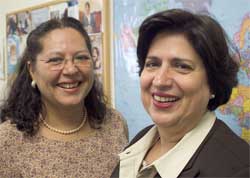Speaking in Tongues
How to stop the spread of English and other "killer" languages? How to fight the perception of multilingualism as a drain on standardized test scores? And is language truly a human right?
Those were just a few of the questions debated at "Imagining Multilingual Schools," a four-day gathering at TC in late September of scholars, teachers and policy experts from 22 countries.
The goals of the conference, which brought together research findings on multilingual schooling from across the globe, were twofold: to promote recognition and respect for traditional minority and indigenous languages; and-in the words of Professor Elana Shohamy of Tel Aviv University-to find ways of overcoming the social, political and educational obstacles that undermine "the imagined."
"Multilingualism is a great asset to our society as well as an individual right within the context of schools and classrooms," said conference co-chair Ofelia García, Professor of Bilingual Education in TC's Department of International and Transcultural Studies. "Moreover, it is becoming the norm internationally."
Co-chair María Torres-Guzmán, Associate Professor of Bilingual Education, added, "This conference and the research presented here are helping to change the way we view multilingualism, in the U.S. and all over the world."
Societies with linguistic majorities penalize themselves by perpetuating monolingualism in their educational systems, asserted Tove Skutnabb-Kangas of the University of Roskilde, Denmark, pointing out that countries from Botswana to New Zealand are struggling with how to protect indigenous languages within their borders.
That includes the United States. This year marks the anniversaries of two landmark legal decisions in the history of multilingual education in the U.S.: the 50th anniversary of Brown v. Board of Education, which paved the way for desegregation of schools, and the 30th anniversary of Lau v. Nichols, which established that for non-English speaking students, an "equal education" must include instruction in their native languages. Indeed, bilingual and multilingual education in the U.S. have always been firmly planted within the context of a larger struggle for civil rights, said Nancy Hornberger, of the University of Pennsylvania.
Yet the U.S. remains one of only two countries that is not a signatory to the U.N. Conference on the Rights of the Child, which recognizes language as a human right. And many speakers argued that the nation's emphasis on standardized testing, as embodied in the federal No Child Left Behind legislation, tends to translate into an insistence on teaching everyone English.
The challenge, then, is to bridge the gap between policy and practice, or, as Jim Cummins of McGill University put it, "to put the reality behind the rhetoric" and enact laws that truly help students develop literacy in their first language.
Meanwhile, examples abound on America's own borders of the growing need for multilingual education. Guadalupe Valdés of Stanford University described a school in El Paso, Texas, where "all students who enroll will graduate from high school fluently bilingual." It's a proficiency, she said, that portrays the single most important determinant of educational policy: the demands of real life.
For more information, visit the Center for Multiple Languages and Literacies.
Published Monday, Oct. 11, 2004
